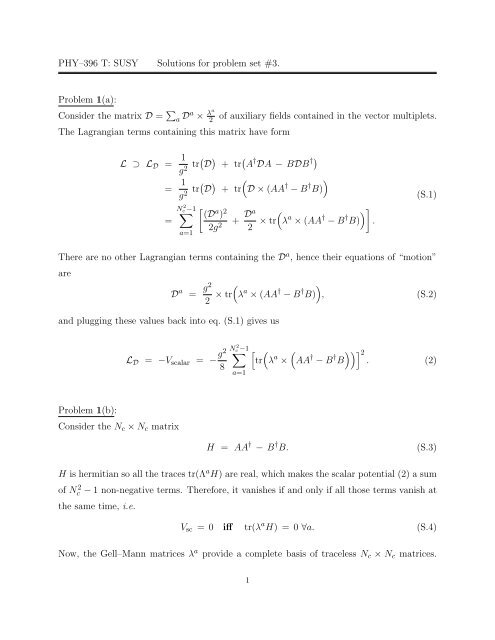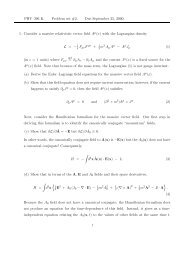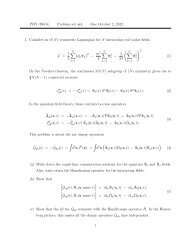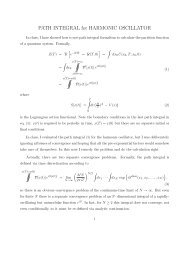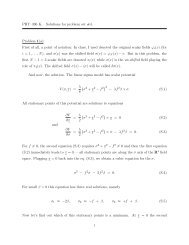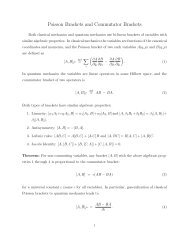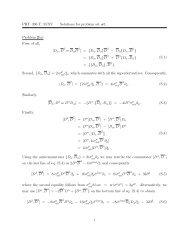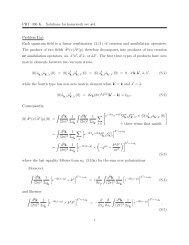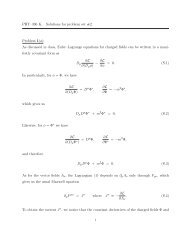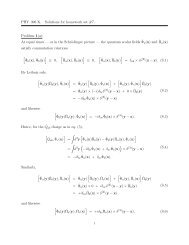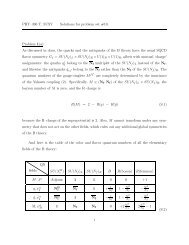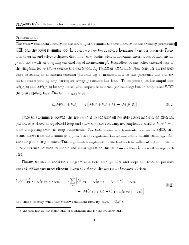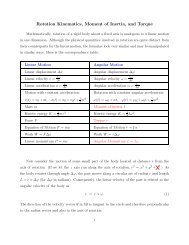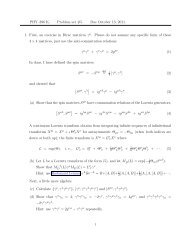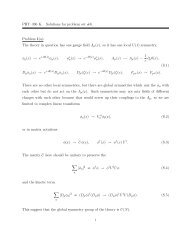PHYâ396 T: SUSY Solutions for problem set #3. Problem 1(a ...
PHYâ396 T: SUSY Solutions for problem set #3. Problem 1(a ...
PHYâ396 T: SUSY Solutions for problem set #3. Problem 1(a ...
- No tags were found...
Create successful ePaper yourself
Turn your PDF publications into a flip-book with our unique Google optimized e-Paper software.
PHY–396 T: <strong>SUSY</strong> <strong>Solutions</strong> <strong>for</strong> <strong>problem</strong> <strong>set</strong> <strong>#3.</strong><strong>Problem</strong> 1(a):Consider the matrix D = ∑ a Da × λa2of auxiliary fields contained in the vector multiplets.The Lagrangian terms containing this matrix have <strong>for</strong>mL ⊃ L D = 1 g 2 tr( D ) + tr ( A † DA − BDB †)= 1 g 2 tr( D ) ()+ tr D × (AA † − B † B)=N 2 c −1∑a=1[ (D a ) 22g 2+ Da2 × tr (λ a × (AA † − B † B)) ] .(S.1)There are no other Lagrangian terms containing the D a , hence their equations of “motion”areD aand plugging these values back into eq. (S.1) gives us= g2 ()2 × tr λ a × (AA † − B † B) , (S.2)L D = −V scalar = − g28N 2 c −1∑a=1[ ( (2tr λ a × AA † − B B))] † . (2)<strong>Problem</strong> 1(b):Consider the N c × N c matrixH = AA † − B † B.(S.3)H is hermitian so all the traces tr(Λ a H) are real, which makes the scalar potential (2) a sumof Nc 2 − 1 non-negative terms. There<strong>for</strong>e, it vanishes if and only if all those terms vanish atthe same time, i.e.V sc = 0 iff tr(λ a H) = 0 ∀a. (S.4)Now, the Gell–Mann matrices λ a provide a complete basis of traceless N c × N c matrices.1
Consequently, the only way a traceless matrixH ′= H − tr(H)N × 1 N c×N c(S.5)may satisfy tr(λ a H ′ ) = tr(λ a H) = 0 <strong>for</strong> all a = 1, . . . , (N 2 c − 1) is if H ′ = 0, i.e.Or in terms of the A and B matrices,H = tr(H)N × 1 N c×N c. (S.6)AA † − B † B = H = c × 1 Nc×N c(3)<strong>for</strong> some real number c = tr(H)/N.Eq. (3) <strong>for</strong> the flat directions applies to SQCD theories with any numbers of colors andflavors. But from this point on, we assume that N f < N c . Consequently, the flavor side of theA matrix is shorter than its color side, so while the hermitian matrix AA † is N c ×N c , its rankis no greater than N f < N c . Likewise, the B † B matrix is N c × N c but its rank ≤ N f < N c .For an hermitian matrix, its rank is the number of non-zero eigenvalues. Since theeigenvalues of the AA † and B † B matrices have to be non-negative, this means that thelowest eigenvalue of each matrix is zero,min(AA † ) = min(B † B) = 0.(S.7)But in light of eq. (3), the eigenvalues of these two matrices differ by c, hencec = min(AA † ) − min(B † B) = 0(S.8)and there<strong>for</strong>eAA † − B † B = 0. (4)Note that the flat directions of SQCD have to satisfy eq. (4) only <strong>for</strong> N f < N c . ForN f ≥ N c they may satisfy eq. (3) with c ≠ 0 instead of eq. (4).2
Lemma <strong>for</strong> parts (c–d) of <strong>Problem</strong> 1:Any complex square matrix M may be written as a product of a real diagonal matrix D andtwo unitary matrices U and V asM = UDV.(S.9)To prove the Lemma, consider two hermitian matrices MM † and M † M, which have thesame eigenvalues because det(MM † − x) = det(M † M − x). Thus, if we diagonalize the twomatrices, we would getMM † = UD 2 U † and M † M = W D 2 W † (S.10)<strong>for</strong> some unitary matrices U and W and the same real diagonal matrix D = diag(d 1 , . . . , d N ).Without loss of generality we can make all the d i non-negative and put them in some fixedorder, e.g. d 1 ≥ d 2 ≥ · · · ≥ d N ≥ 0.Now consider the matrix˜M = U † MW.(S.11)In light of eqs. (S.10) we have˜M ˜M † = U † MM † U = D 2 ,˜M † ˜M = W † M † MW = D 2 ,(S.12)which tells us that ˜M can be diagonalized in the same basis as D and that its eigenvaluesm i have absolute values d i . In other words˜M = DY = Y D (S.13)<strong>for</strong> some unitary matrix Y which commutes with D. Consequently,M = U ˜MW † = U × D × Y W † (S.14)in accordance with the Lemma (S.9) <strong>for</strong> V = Y W † .3
The decomposition (S.9) is not unique: we may change U ↦→ UX, V ↦→ X † V <strong>for</strong> anyunitary matrix X which commutes with D, i.e. <strong>for</strong> any block-diagonal unitary matrix Xwhose blocks correspond to degenerate eigenvalues d i = · · · = d j . When all the eigenvaluesare non-zero, this is the only redundancy of the decomposition (S.9). However, when somed i = 0 there is a larger redundancy U ↦→ UX, V ↦→ X ′† <strong>for</strong> different X and X ′ , as long asthe difference between them is limited to the block corresponding to the d i = 0.<strong>Problem</strong> 1(c):First, let’s prove that any N c × N f matrix A can be written asA = U C ×⎛⎜⎝D Nf ×N f⎞⎟⎠ × V A(S.15)0 Nf ×(N c−N f )where U C ∈ SU(N c ), V A ∈ U(N f ) and D is a real ≥ 0 diagonal N f × N f matrix. We maythink of the A matrix as a linear map from the flavor space onto the color space. The imageof the flavor space under this map is an N f dimensional subspace of the color space, and asuitable SU(N c ) symmetry of the color space can move this image to the first N f colors. Inmatrix language, this means that⎛⎞à Nf ×N f⎜⎟A = U × ⎝⎠0 (Nc−N f )×N f(S.16)<strong>for</strong> some U ∈ SU(N c ). TheLemma (S.9),à is a square matrix so we may decompose it according to theà = Ũ × D × V A (S.17)where Ũ and V A are N f × N f unitary matrices. Without loss of generality we may takedet(Ũ) = 1 since the overall phase can be moved from the Ũ factor in eq. (S.17) to the V Afactor. This make Ũ ∈ SU(N f) and we may promote it to an SU(N c ) matrix asÛ =( )ŨNf ×N f0 Nf ×(N c−N f )0 (Nc−N f )×N f1 (Nc−N f )×(N c−N f )∈ SU(N c ).(S.18)4
Consequently, eq. (S.17) promotes to⎛⎜⎝Ã Nf ×N f⎞ ⎛⎟⎠ = Û × ⎜⎝D Nf ×N f⎞⎟⎠ × V A(S.19)0 Nf ×(N c−N f )0 Nf ×(N c−N f )and there<strong>for</strong>e⎛⎞A = U C ×⎜⎝D Nf ×N f⎟⎠ × V A(S.15)0 Nf ×(N c−N f )where U C = UÛ ∈ SU(N c).Now let the A matrix have this <strong>for</strong>m while we are looking at the B matrix. In light ofeq. (4) we must haveB † B = AA † = = U C ×or equivalently(BU C ) † × (BU C ) = U † C AA† U C =( D2Nf ×N f0 Nf ×(N c−N f )0 (Nc−N f )×N f0 (Nc−N f )×(N c−N f ))( D2Nf ×N f0 Nf ×(N c−N f )0 (Nc−N f )×N f0 (Nc−N f )×(N c−N f )× U † C(S.20)). (S.21)Now let write the N f × N c matrix B × U C as an N f × N f block ˜B and an N f × (N c − N f )block Q,B × U c =(˜BIn terms of these blocks, matrix equation (S.21) means)∣ Q . (S.22)˜B † × ˜B = D 2 , ˜B† × Q = 0, Q † × Q = 0. (S.23)Consequently, we must have Q = 0 (otherwise Q † Q ≠ 0) while˜B = V B × D(S.24)5
<strong>for</strong> some unitary N f × N f matrix V B . In terms of the original B matrix, this means( ∣ )∣∣∣B = V B × D Nf ×N f0 Nf ×(N c−N f ) × U C (S.25)where the U C ∈ SU(N c ) and the diagonal D are the same as in eq. (S.15). Quod eratdemonstrandum.<strong>Problem</strong> 1(d):The moduli space of a <strong>SUSY</strong> gauge theory is the space of zero-potential scalar VEVs modulogauge symmetries. In our case, it comprises pairs of matrices (A, B) which satisfy eqs. (4),but the pairs (A, B) and (UA, BU † ) are equivalent <strong>for</strong> any gauge symmetry U ∈ SU(N c ).In terms of eqs. (5) this means that fixing a point in the moduli space involve specifyingthe D, V A , and V B matrices, but not the U C . Moreover, some of the (D, V A , V B ) data isredundant: For any unitary N f × N f matrix X which commutes with D, changing V A ↦→V ′ A = XV A and V B ↦→ V ′ B = V BX † leads to the same A and B provides we also changeU C ↦→ U C ×( X†N f ×N f0 Nf ×(N c−N f )0 (Nc−N f )×N fZ (Nc−N f )×(N c−N f )),any Z ∈ U(N c − N f ) such thatdet(X) × det(X † ) = 1,(S.26)In other words, the trio (D, XV A , V B X † ) describes the same point in the moduli spaces as(D, V A , V B ) <strong>for</strong> any unitary matrix which commutes with D.Now, suppose we are given the matrix M of holomorphic invariants. According to theLemma (S.9), it can be decomposed into one real diagonal and two unitary matrices asM = V B × D 2 × V A .(S.27)Plugging these (D, V A , V B ) matrices into eqs. (5) we immediately get a point (A, B) in themoduli space, and its easy to see that <strong>for</strong> any U C ∈ SU(N c )⎛( ∣ )∣∣∣B × A = V B × D Nf ×N f0 Nf ×(N c−N f ) × U † C × U ⎜C × ⎝= V B × D × D × V A = M.D Nf ×N f0 Nf ×(N c−N f )⎞⎟⎠ × V A(S.28)Moreover, the redundancy of the decomposition (S.27) is precisely the redundancy of the6
(D, V A , V B ) “coordinates” of the moduli space: we may change V A ↦→ XV A and V B ↦→ V B X †in eq. (S.27) without changing the moduli matrix M (<strong>for</strong> a unitary X which commutes withD), but this would still be the same point in the moduli space.There is a larger redundancy of the decomposition (S.27) if some of the eigenvalues ofD are zero. In this case we may change V A ↦→ XV A and V B ↦→ V B X ′† <strong>for</strong> different unitarymatrices X and X ′ as long as the difference is limited to the zero eigenblock of D. But in thiscase, the products D × V A ↦→ DXV A and V B × D ↦→ V B X ′† D are completely unaffected bythose blocks of X and X ′ because they end up multiplying the zero block of D. Consequently,the extra redundancy of the decomposition (S.27) does not affect the matrices A and B.The bottom line is, the holomorphic N f × N f matrix M = BA uniquely specifies a pointin the moduli space of SQCD with N f < N c . Quod erat demonstrandum.<strong>Problem</strong> 2:Consider a superfield Feynman graph with L loops, V vertices (either ∫ d 2 θΦ n of ∫ d 2¯θΦ n,any n), and P + P ′ internal lines. Specifically, P internal lines of types ΦΦ or ΦΦ and P ′internal lines of types ΦΦ or ΦΦ. Together these propagators carry 4P + 2P ′ superspacederivatives. However, each superpotential vertex cancels two derivatives (either 1/D 2 or1/D 2 , depending on chirality), so the net number of the superderivatives is#SD = 4P + 2P ′ − 2V.(S.29)Now, according to the Euler theorem,L − (P + P ′ ) + V = +1. (S.30)Consequently, 2P + 2P ′ − 2V = 2L − 2 and hence#SD = 2P + 2L − 2. (6)Note that in all loop graphs and also in all tree graphs with at least one ΦΦ (or ΦΦ)propagator, this net number of superderivatives is non-negative, and that’s why the resultingsuperfield amplitude can always be written as a d 4 θ integral of a local operator (a polynomialin superfields and maybe their derivatives) times a superspace-blind finction of momenta.7
The exception are tree graphs where all propagators are ΦΦ and all the external fieldsare chiral, or all the propagators are ΦΦ and all the external fields are antichiral. In this case,the amplitude looks like ∫ d 2 θΦ · · · Φ or ∫ ∫ d 2¯θΦ · · · Φ and it leads to finite corrections to thesuperpotential of the effective low-energy theory from which some heavy chiral superfieldshave been integrated out. I shall explain how this works in class, probably be<strong>for</strong>e you get toread these solutions.<strong>Problem</strong> 3:Now consider a general superfield Feynman graph <strong>for</strong> the SQED. Suppose it has L loops, E Vexternal and P V internal wavy lines belonging to the vectors, E C external and P C internalstraight lines belonging to all types of chiral and antichiral superfields, and V n vertices havingn vector lines (n = 1, 2, . . .) and 2 chiral lines; the net number of vertices is V = ∑ n V n.In the Feynman gauge, the superspace derivatives come only from the chiral propagators;there are 4 or 2 derivatives in each such propagator, depending on its type. On the otherhand, the SQED vertices do not carry negative powers of D or D, so the net number ofsuperderivatives is#SD ≤ 4P C .(S.31)This inequality is saturated if all chiral propagators are of the AA or BB types; this isautomatic when m = 0.Since each SQED vertex has precisely two chiral lines, any graph has2V = 2P C + E C . (S.32)Consequently, the number of the superderivatives is limited by#SD ≤ 4V − 2E C .In a loop graph, 4L of these superderivatives are needed to close the loops, i.e. to eliminatethe δ (4) ∣(θ 1 − θ 2 ) factors in each loop. The remaining superderivatives may put∣θ1=θ 28
loop momenta in the numerator (via the anticommutators {D α , D ˙α } = 2q α ˙α ) of the ∫ d 4L qintegral. In general, the numerator is a polynomial in loop momenta of degreeD num ≤ 1 2()#SD − 0 4L≤ 2V − E C − 2L(S.33)while the denoninator has degreeD denom = 2P all = 2P C + 2P V (S.34)and the integral is over 4L momentum dimensions. This leads to the superficial degree ofdivergence∆ = 4L + D num − D denom ≤ 2L + 2V − 2P all − E C . (S.35)By the Euler theorem L + V − P all = 1, which gives us∆ ≤ 2 − E C . (12)This result limits the divergent amplitudes of SQED to just two classes: (1) Two scalars(of opposite charges) and any number of vectors, and (2) just the vectors without any scalarsat all. Both classes are infinite, which seems too much <strong>for</strong> a renormalizable theory. However,conservation of the supersymmetrized electic current leads to powerfull Ward identities whichdrastically reduce the number of independent divergences from infinity to just two: δZ A =δZ B and δe. I shall explain how this works later in class.9


